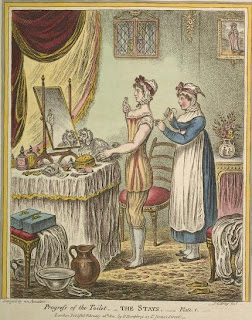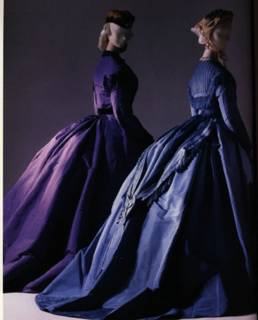I most definitely have caught the sewing bug. In addition to helping one of my friends sew her civil war costume (and now a Regency costume as she gets sucked into my world), I've been busy to. Remember
Mini? Well, she's finally finished and ready to get to work:

Mom helped me fit the cover last summer (that was NOT as easy as their 12 step plan made it sound). I got it out this weekend and finally put it on the foam dummy to make the final adjustments (even after it fits you, you generally have to take out a few more inches because of how strong the foam is). It finally is a double of me! Mini is now sporting my Regency stays, because I'm going to fit my bodiced petticoat on her as I work on it this week. Let me tell you what a joy it was squishing the resistant foam even more with the stays! The Jane Austin ball is in early August, so I'm making my
Regency ball gown from the Sense and Sensibility pattern out of the
white Sari I brought home from India. I only wish I could have gotten a head start on it this weekend, but after getting Mini all set up today (Sunday) I suddenly didn't feel so great and wound up sleeping most of the afternoon away.

In other news, G Street fabrics had an Ubber sale this weekend (up to 70% off), plus I had a 25% off coupon for one already reduced item. Missy came with me, and we tore through the fabric store for a good four hours, hunting for deals. Above (the green cotton velvet) was an AMAZING find in the $2 bin. I can't believe it was there - over six yards! I got a coordinating satin to line it with, and am planning on auction this one on ebay. At that price, I can actually turn a profit! I went ahead and bought some more baby flannel as well - I have enough left over materials that I'm making another Gainsborough hat to auction off (this time in left-over pink taffeta from my Robe Francaise). I'll let you know when they go on sale. All proceeds go towards my Costume Con 2009 fund.

My 18th century
pocket hoops on one their last legs. Some of the reed boning snapped in the last move, and during the
Frederickburg event, some of the boning started poking through the channels. Apparently a much better fabric selection is cotton ticking, and striped ticking was the favored look of the 18th century. Again, a great price, so I can remake my
JP Ryan pocket hoops.

The pictures above are for a new 18th century outfit. The cotton print (on the left) I picked up in Amish country for $4 a yard, and is going to be an 18th century pet-en-l'air. The pink is going to be for the skirt, and is a poly bengaline/faille that I spotted this weekend at G Street Fabric. I almost never use poly fabrics anymore, but it was a great price, it's a fairly convincing silk imitation, and the color matched beautifully. All of the silk options started in the $15 a yard (even on sale), so I decided this would work out. I already have the patterns I need - I'm going to reuse my
JP Ryan Robe a la Francaise pattern, but make the Pet en l'Air view instead (it's more like a jacket than a dress).

This was another Amish country find. It's a plum-colored plaid in homespun cotton from India (again...an amazing price at about $4 a yard). I saw it and fell in love with it. It's going to be the fabric I use for a
civil war day gown instead of a visiting dress like I mentioned in my last planning post. I still have my silk for the visiting dress...not sure which one I'll make up first. Depends on my mood I suppose.

Perhaps one of the luckiest finds ever, this was another Amish country purchase. I needed a fabric for the forepart of the
Tudor gown (mentioned in my last planning post), but I kept only finding silk damasks that were $50 a yard and completely out of the question for my budget. I found five yards of the pictured fabric in a $2 remnant bin. This fabric would be at least $25 a yard in a fabric store. I don't know what it's made out of - I'm fairly certain it isn't silk. Most likely some sort of a cotton/poly blend. At $2 a yard, who cares?
For anyone who's eyes are bugging at all the fabric: this is how I keep the costs of my hobby down. I always have about 10 project in mind, and I hunt for suitable fabric during sales. If the fabric I want isn't there, the project goes on hold (for example - the wool was all overpriced, and the colors were all wrong, so the 18th century riding gown is on hold). So...yes, it's a lot of fabric, but I'm probably set for the next year, with the exception of Costume Con purchases.
 It's not hemmed yet: I'll do that at the same time I hem my gown. Check out the great Regency silhouette from the side! I was a bit concerned about how the stays were pushing up my cleavage, but with the petticoat over it, I can really start to see how this is going to look with the dress. Very period!
It's not hemmed yet: I'll do that at the same time I hem my gown. Check out the great Regency silhouette from the side! I was a bit concerned about how the stays were pushing up my cleavage, but with the petticoat over it, I can really start to see how this is going to look with the dress. Very period! Compare my silhouette to this print by James Gillray entitled "Stays" (it's one from his series titled "The Progress of the Toilette). Not bad, eh?
Compare my silhouette to this print by James Gillray entitled "Stays" (it's one from his series titled "The Progress of the Toilette). Not bad, eh? I went ahead and made up a muslin toile of my ball gown. The back fits beautifully:
I went ahead and made up a muslin toile of my ball gown. The back fits beautifully: I'm not so sure about the front. It looks a bit big. Too poofy and too long on bottom. Any opinions? I may cut out one cup size smaller and see if that improves the fit...but one cup smaller will also shorten the back which I think is perfect. It's sort of hard to tell at this point how the fit is...according to the pattern for my size, I'll add a drawstring waistband to the dress so that I can make sure the bottom edge of the Empire waist fits like a glove. Hmm...
I'm not so sure about the front. It looks a bit big. Too poofy and too long on bottom. Any opinions? I may cut out one cup size smaller and see if that improves the fit...but one cup smaller will also shorten the back which I think is perfect. It's sort of hard to tell at this point how the fit is...according to the pattern for my size, I'll add a drawstring waistband to the dress so that I can make sure the bottom edge of the Empire waist fits like a glove. Hmm... I want to make sure I get my toile right before I touch my fashion fabric. There's no more where it came from (handwoven in India), and I've been safeguarding this one-of-a-kind beauty. Here it is draped over Mini so you can get an idea of what the gown will look like. The gold border is only going to be used around the hem, and possibly for the waistband and sleeve bands.
I want to make sure I get my toile right before I touch my fashion fabric. There's no more where it came from (handwoven in India), and I've been safeguarding this one-of-a-kind beauty. Here it is draped over Mini so you can get an idea of what the gown will look like. The gold border is only going to be used around the hem, and possibly for the waistband and sleeve bands.

























